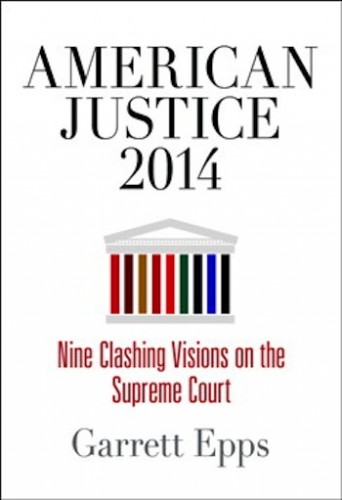Book Review: “American Justice 2014” — A Sturdy Look at the Current Supreme Court
The most important takeaway from American Justice 2014 is the potential danger, from Epps’s perspective, of the growing influence of Justice Alito.
American Justice 2014: Nine Clashing Visions on the Supreme Court by Garrett Epps. University of Pennsylvania Press, 192 pages, $16.95.
By Blake Maddux

Garrett Epps is a professor of law at the University of Baltimore, a contributing writer for The Atlantic (“I am not at the [Supreme C]ourt to be a dispassionate observer. I write what I think.”), and the author of numerous books, including American Epic: Reading the U.S. Constitution (2013)—which Oxford University Press issued in paperback this month—and most recently American Justice 2014: Nine Clashing Visions on the Supreme Court. In addition to these and other works of nonfiction, he has written two novels; he teaches creative writing as well as courses in constitutional law. (He has a master’s degree in English from Hollins College in addition to a B.A. from Harvard and J.D. and LL.M. degrees from Duke University.)
American Justice 2014 is a slim but not necessarily inconsequential volume. Given this prolific writer’s oeuvre, it feels a bit like a placeholder, but it is sturdy one. The book serves as a handy refresher or crash course for Supreme Court enthusiasts who need either or both. Although some chapters seem to tell the reader more about a justice other than the one to whom the given chapter is devoted, the effect—presumably intended—is that the nine concise chapters reinforce each other nicely.
Despite the year that is mentioned in the book’s title, the focus of the book is on the Supreme Court’s October 2013 term (“OT13” to Court observers), so-called because it began on October 7, 2013. Since it ran through June 30 of the following year and because the decisions in all but one of the cases that Epps discusses were issued in 2014, the main title is hardly a misnomer.
The subtitle, however, is a bit problematic. Subtitles, which sometimes are tacked on by publishers, are apt to be hyperbolic or dramatic in order to reel in skeptical buyers. “Nine Clashing Visions on the Supreme Court” is no exception.
Those who write or report about the Supreme Court divide the justices into the “conservative” ones—Chief Justice John Roberts and Associate Justices Antonin Scalia, Clarence Thomas, and Samuel Alito—and the “liberal” ones—Associate Justices Ruth Bader Ginsburg, former Harvard Law professor and Cambridge resident Stephen Breyer, Sonia Sotomayor, and former Harvard Law Dean Elena Kagan. Justice Anthony Kennedy is generally grouped with the conservatives, but he is more importantly the “swing vote,” i.e., the justice whose vote attorneys who argue before the court cannot always confidently include in their win column.
It is tempting to attribute the conservative and liberal groupings to the fact that those in the former category—plus Kennedy—are all appointees of Republican presidents and those in the latter are appointees of Democrats. However, there is a long history of presidents, usually Republicans, living to regret their choices for the high court. This phenomenon was most famously described by Dwight D. Eisenhower in his possibly apocryphal statement that his two biggest mistakes as president were both on the Supreme Court.
Although there are exceptions, it is likely that the Republican appointees are going to vote together and that the Democrats appointees will do the same. That is, in 5-4 decisions, Justice Kennedy is likely to be the fifth vote along with the four conservatives or four liberals. The frequency, though not inevitability, of such vote line-ups is what makes the existence of “nine clashing visions” difficult to swallow. In fact, the four core conservatives voted together in all nine of the cases that Professor Epps discusses—Kennedy joined them in five, Breyer in one—and the four core liberals did likewise in eight (Kennedy voted with them in two, and two others were unanimous).

The Supreme Court — circa 2014
Nine clashing visions? Hardly. One might be able to count at least three: the conservative vision, the liberal vision, and whatever Justice Kennedy sees in any given case. However, this number might be said to double when one considers the differences among the three “originalists” on the Supreme Court. If I many coin a few phrases, with the help of Epps’s descriptions, I would call Clarence Thomas’s view “backward-looking non-stare decisis originalism,” Antonin Scalia’s “backward-looking stare decisis originalism,” and Samuel Alito’s “forward-looking stare decisis status unclear originalism.” (“Stare decisis” is Latin for “stand by the decision” and refers to the deference that justices pay to precedents set by earlier Supreme Court decisions.)
Epps quotes Scalia as saying that Thomas “does not believe in stare decisis, period.” Not-so-subtly criticizing Thomas’s philosophy, Scalia also said in reference to his junior colleague, “I am an originalist, but I am not a nut.”
Although Scalia had long been “the intellectual quarterback of the conservative bloc,” Epps asserts that by spring 2013, “Scalia’s philosophy of ‘originalism’ was showing its age … Justice Alito, in particular, seemed to take pleasure in openly mocking it.”
The best-known instance of this open mocking was when, during a case deciding whether the First Amendment protected the sale of violent video games to children, Alito said, “I think what Justice Scalia wants to know is what James Madison thought about video games. Did he enjoy them?”
While this might constitute a disagreement over a method of constitutional interpretation, it rarely disturbs the reliability of the three of them being on the same side when the time comes to count the votes. Therefore, Epps is really no closer to demonstrating the existence of nine clashing visions than he was before.
The most important takeaway from American Justice 2014 is the potential danger, from Epps’s perspective, of the growing influence of Justice Alito. Epps writes, “No single appointment of the past generation had shifted the tone and jurisprudence of the court as decisively as the substitution of Alito for Sandra Day O’Connor in 2006 … Like a heavy item of cargo in a ship’s hold, he quickly caused a noticeable list to the right.”
O’Connor, a 1981 nominee of Ronald Reagan and the first woman to serve on the Supreme Court, has not been shy about expressing her disappointment in the Court’s recent direction. A few days after the Citizens United v. Federal Election Commission decision in 2010, O’Connor said, “Gosh, I step away for a couple of years and there’s no telling what’s going to happen.”
Although Epps does not include this quotation, he does describe the extent to which O’Connor’s fears have been borne out: “Alito wrote and announced [the two final blockbuster decisions of OT13], and Nino Scalia did not even appear on the bench. The empty chair underscored Alito’s emergence—and Scalia’s eclipse—as the brains of the court’s right wing.”
This is the second point in the book at which Epps describes Scalia as having been “eclipsed” by another, far more junior colleague. Twenty pages before the above observation, Epps states that Justice Sotomayor—after first appearing the bench in October 2010—“soon eclipsed even Scalia as the court’s most aggressive questioner.”

Author and columnist Garrett Epps — he observes the Supreme Court with a critical eye.
Liberals might delight in the prospect of Scalia’s fading into irrelevance, but they should watch what they wish for if Alito is going to be the storm cloud that obscures him. As Epps informs us, the same justice who mouthed “not true” in response to President Obama’s criticism of the Citizens United decision at the 2010 State of the Union Address also, during the 2014 announcement of the Burwell v. Hobby Lobby Stores decision, “showed elaborate scorn during Ginsburg’s dissent, shaking his head, rolling his eyes, and mouthing the word ‘no’ as she spoke.”
Furthermore, Epps continues, Alito “can write with acid scorn of those with whom he does not empathize—civil rights plaintiffs, for example, or prison inmates.”
Conservatives might be perfectly happy to hand the ball over the Alito, but with soon-to-be 82-year-old Ruth Bader Ginsburg unlikely to stay on through one (let along two) terms of what might be a Republican administration starting in 2017, liberals might be right to tremble at that possibility.
(And no, neither I nor Professor Epps wholeheartedly endorse the idea that Ginsburg should resign so as to allow President Obama to appoint her replacement.)
Given the resources—intellectual and otherwise—that he has, Epps probably could have written American Justice 2014 in his sleep. That said, the likely effortlessness with which he wrote it paves the way for an equally smooth ride for the reader. Given that the book’s intended audience seems to be those who are interested in the Supreme Court but do not have degrees in political science or law, this makes the book a successful, if slight, excursion.
Blake Maddux is a freelance journalist and regular contributor to DigBoston and The Somerville Times. He recently received a master’s degree from Harvard Extension School, which awarded him the Dean’s Thesis Prize in Journalism. A native Ohioan, he moved to Boston in 2002 and currently lives with his wife in Salem, Massachusetts.
Tagged: American Justice 2014, Antonin Scalia, Blake Maddux, Clarence Thomas, Garrett Epps, Ruth Bader Ginsburg

